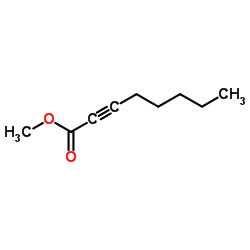Methyl 2-octynoate

Methyl 2-octynoate structure
|
Common Name | Methyl 2-octynoate | ||
|---|---|---|---|---|
| CAS Number | 111-12-6 | Molecular Weight | 154.206 | |
| Density | 0.9±0.1 g/cm3 | Boiling Point | 218.5±0.0 °C at 760 mmHg | |
| Molecular Formula | C9H14O2 | Melting Point | N/A | |
| MSDS | Chinese USA | Flash Point | 88.9±0.0 °C | |
| Symbol |

GHS07 |
Signal Word | Warning | |
|
Allergic contact dermatitis from methyl heptine and methyl octine carbonates.
Contact Dermatitis 18(3) , 174-5, (1988)
|
|
|
[Newly recognized primary sensitizers, methyl heptine carbonate and costus root oil to evaluate cutaneous delayed hypersensitivity on various chest diseases (author's transl)].
Nihon Kyobu. Shikkan Gakkai Zasshi 19(7) , 478-86, (1981)
|
|
|
[Methyl heptine carbonate skin test in lung cancer--correlation with stage and prognosis].
Gan No Rinsho. 30(4) , 340-3, (1984) Results of methyl heptine carbonate skin tests were compared with DNCB skin test results in 155 patients with chest diseases. Reactions to methyl heptine carbonate and DNCB were similar in 142 of 155 patients (92%). Forty-two lung cancer patients and 42 contr... |
|
|
[Cutaneous delayed hypersensitivity to methyl hepatine carbonate in pulmonary tuberculosis].
Nihon Kyobu. Shikkan Gakkai Zasshi 24(10) , 1066-70, (1986)
|
|
|
Is there evidence that methyl heptine carbonate causes allergic contact dermatitis?
Cutan. Ocul. Toxicol. 25(4) , 259-71, (2006) The fragrance material methyl heptine carbonate has been cited as a moderately frequent cause of cosmetics-related allergic contact dermatitis. A review of the literature shows that when the underlying clinical data are analyzed, there is only one published c... |
|
|
Nickel-catalyzed regioselective carbocyclization of ortho-halophenyl ketones with propiolates: an efficient route to disubstituted indenols.
Chem. Commun. (Camb.) (9) , 942-3, (2002) Carbocylization of o-halophenyl ketones with propiolates in the presence of Ni(dppe)Br2 and Zn powder in acetonitrile at 80 degrees C afforded the corresponding 2,3-disubstituted indenols. |
|
|
Determination of suspected allergens in cosmetic products by headspace-programmed temperature vaporization-fast gas chromatography-quadrupole mass spectrometry.
Anal. Bioanal. Chem 397(6) , 2579-91, (2010) In the present work, a strategy for the qualitative and quantitative analysis of 24 volatile compounds listed as suspected allergens in cosmetics by the European Union is reported. The list includes benzyl alcohol, limonene, linalool, methyl 2-octynoate, beta... |